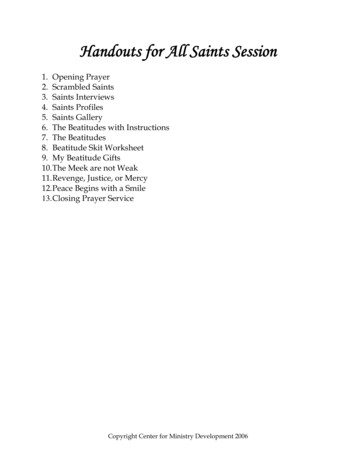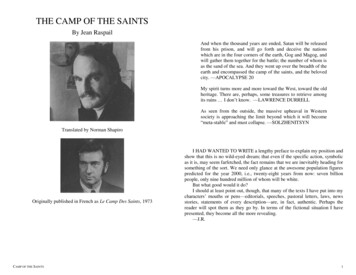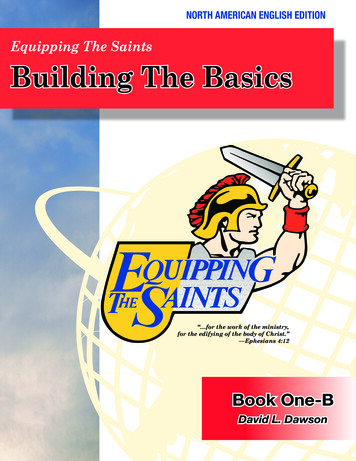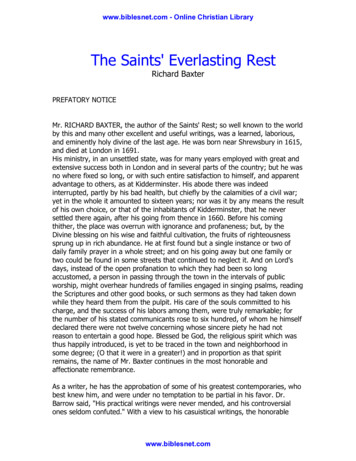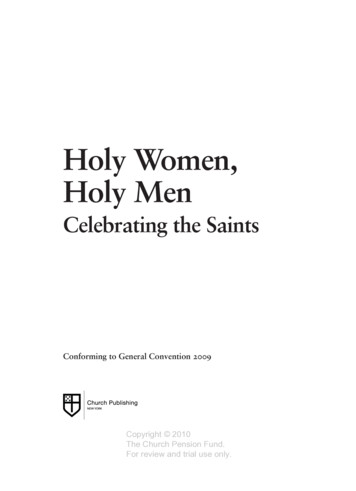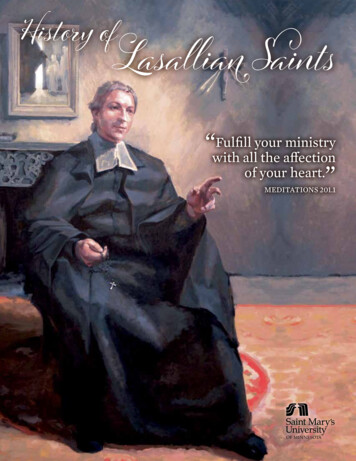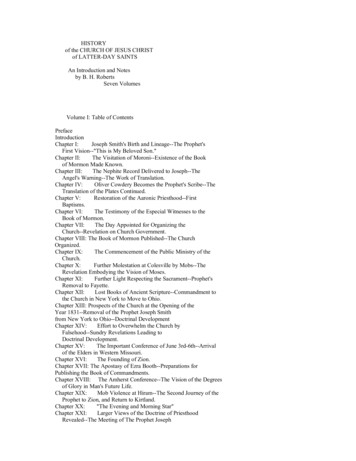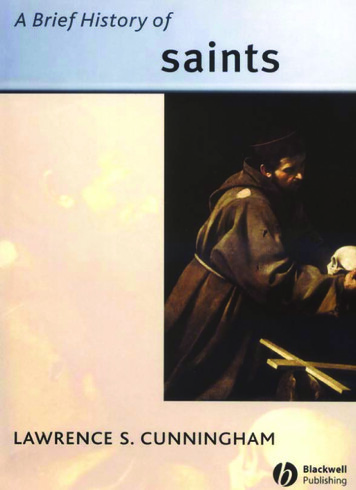
Transcription
A Brief History ofSaints
Blackwell Brief Histories ofReligionThis series offers brief, accessible, and lively accounts of key topicswithin theology and religion. Each volume presents both academic and general readers with a selected history of topics whichhave had a profound effect on religious and cultural life. Theword “history” is, therefore, understood in its broadest culturaland social sense. The volumes are based on serious scholarshipbut they are written engagingly and in terms readily understoodby general readers.PublishedAlister E. McGrath – A Brief History of HeavenG. R. Evans – A Brief History of HeresyTamara Sonn – A Brief History of IslamDouglas J. Davies – A Brief History of DeathLawrence S. Cunningham – A Brief History of SaintsForthcomingMichael Banner – A Brief History of EthicsCarter Lindberg – A Brief History of LoveCarter Lindberg – A Brief History of ChristianityDana Robert – A Brief History of MissionPhilip Sheldrake – A Brief History of SpiritualityKenneth Appold – A Brief History of the ReformationDennis D. Martin – A Brief History of MonasticismMartha Himmelfarb – A Brief History of the Apocalypse
A Brief History ofSaintsLAWRENCE S. CUNNINGHAM
2005 by Lawrence S. CunninghamBLACKWELL PUBLISHING350 Main Street, Malden, MA 02148-5020, USA108 Cowley Road, Oxford OX4 1JF, UK550 Swanston Street, Carlton, Victoria 3053, AustraliaThe right of Lawrence S. Cunningham to be identified as the Author of thisWork has been asserted in accordance with the UK Copyright, Designs, andPatents Act 1988.HAll rights reserved. No part of this publicationmay be reproduced, storedin a retrieval system, or transmitted, in any form or by any means, electronic,mechanical, photocopying, recording or otherwise, except as permitted by theUK Copyright, Designs, and Patents Act 1988, without the prior permission ofthe publisher.First published 2005 by Blackwell Publishing LtdLibrary of Congress Cataloging-in-Publication DataCunningham, Lawrence.A brief history of saints / Lawrence S. Cunningham.p. cm.—(Blackwell brief histories of religion)Includes bibliographical references and index.ISBN 1-4051-1401-0 (hardcover : alk. paper)—ISBN 1-4051-1402-9(pbk : alk. paper) 1. Christian saints—Cult—History. 2.Canonization—History. I. Title. II. Series.BX2333.C86 2004235′.2′09—dc222004011685A catalogue record for this title is available from the British Library.Set in 10/12.5pt Meridienby Graphicraft Limited, Hong KongPrinted and bound in the United Kingdomby TJ Press International, Padstow, CornwallThe publisher’s policy is to use permanent paper from mills that operate asustainable forestry policy, and which has been manufactured from pulp processed using acid-free and elementary chlorine-free practices. Furthermore, thepublisher ensures that the text paper and cover board used have met acceptableenvironmental accreditation standards.For further information onBlackwell Publishing, visit our website:www.blackwellpublishing.com
ContentsList of IllustrationsIntroductionvii11 The Saint: Beginnings5BeginningsThe MartyrsLiteratureVenerationAfter Constantine8111316182 The Bureaucratization of Sanctity28Liturgical Memory of the SaintsThe Saintly LegendRegularizing SainthoodA Test Case: Francis of AssisiThe Christian EastThe Many Meanings of the SaintsPilgrimageVenerating Saints: A Theological Clarification28313639444649513 Reformations: Protestant and Catholic54The Age of the Reformers54Contentsv
TheTheTheTheCatholic ReformationNew MartyrsPapal Curia and CanonizationSaints and Scholarship4 Towards the Modern WorldWorlds DividedNew Forms of Religious LifeDoctors of the ChurchThe StaretsThe Tractarians and the Saints5 The Twentieth CenturySchools of SpiritualityA New Saintliness?The New MartyrsJohn Paul II: Saints and EvangelizationAnglican and Lutheran Calendars6 The Saints, World Religions, and the FutureSome TerminologySaints as a Theological ResourceSaints and the Continuity of Religious TraditionAppendix I: Patron SaintsAppendix II: Iconography of the SaintsNotesSelect BibliographyIndexvi 30136139148151155162169
List of Illustrations1Procession of saints in the Church of Sant’ApollinareNuovo in Ravenna, Italy2 Saint Francis of Assisi (?1181–1226)3 Saint Francis Xavier (1506–1551)4 The colonnaded arcade around St Peter’s Square,Rome5 A woodcut from Foxe’s Book of Martyrs (1563)6 The Altar of the Chair in St Peter’s Basilica, Rome7 An icon of Saint Seraphim of Sarov (1759–1833)8 Mohandas Gandhi (1869–1948)9 Mother Teresa of Calcutta (1910–1997)10 Edith Stein (Teresa Benedicta of the Holy Cross,1891–1942)11 Westminster Abbey’s homage to the contemporarymartyrs30406467709094112113117119List of Illustrations vii
IntroductionThe popular American singer, Billy Joel, sings a lyric in whichhe confesses that he would rather “laugh with the sinner / thancry with the saints.” By contrast, the old New Orleans jazz favorite“When the Saints Go Marching in” insists that “I want to beamong that number . . .” These two popular songs indicate thetwo polar images of saints: on the one hand, dreary, pinched,and lugubrious mourners and haters of a good time and, on theother, the glorious end of human life.The matter of the saints is not made easier because we are theheirs of a long artistic tradition, most amply documented in oldRoman Catholic churches, of figures who seem to have lived ina distant past and whose background is almost always depictedin gold leaf. Many Catholics of a certain age have had theirimage of saints shaped profoundly by holy cards, stained-glasswindows, garishly polychromed plaster-of-Paris statues, as wellas innumerable paintings that are often jejeune and sentimental.Some of this older art is valued as works of high culture, whilea good deal of it found in local parishes is luridly bad. Somesaints are identified with ethnic pride. In the city where I reside,the churches founded by immigrant communities in the lateIntroduction 1
nineteenth and early twentieth centuries tell an informed personwhere the communities originated because the newcomersbrought their patronal saints with them: Saint Patrick (Ireland),Saint Bavo (Belgium), Saint Adalbert (Poland), Saint Stephen(Hungary), Saint Antony of Padua (Italy), and so on.It is also true that some saints have found admirers because theyhave been sentimentalized to fit the age. Every self-respecting suburban garden center can supply a concrete statue of Saint Franciswith a bird perched on his shoulder, and over thirty filmmakers,going back before the “talkies,” have given us versions of SaintJoan of Arc. Other saints, like Valentine (there were actually twomartyrs of that name), have become submerged into the popularsentimentality of the greeting-card companies and chocolatemanufacturers. Chicago’s Saint Patrick’s Day includes turning thecity’s river green with vegetable dye. The mutation of the EasternSaint Nicholas of Myra into Santa Claus will be narrated in itsproper place. One must decide whether the sentimentality of thereligious person or that of the secular one is the more misleading.This brief history of saints will focus on the roots, development, and significance of the saints in the Christian tradition ingeneral and in the Roman Catholic tradition more particularly.My decision to emphasize the Roman Catholic Church in thiswork derives from a twofold conviction. First, one should speakonly about those things about which one knows something. Asa Roman Catholic teaching in a Catholic university, one of myresearch interests has been the meaning and significance of thesaints, but in the course of my work I have kept my eye on thetradition of the saints in other Christian communities and thatinterest will be honored in this work. Second, most readers inthe West are more familiar with the Roman Catholic tradition ofthe saints if for no other reason than that most of our majormuseums well represent that tradition, and, further, that ourpopular culture still has lingering memories of the old traditionof the cult of the saints, even if most people could not say whothe aforementioned Saint Valentine was or how Saint Nicholas2 Introduction
became Santa Claus. We will pay a fair amount of attention tothe Christian East because Orthodoxy does share a robust cult ofthe saints, even though many who do not belong to that ancientChristian tradition are unfamiliar with it.There will be more than one occasion in this work when theargument will be made that the tradition of the saints should beof interest to others besides social historians, students of iconography, folklorists, and experts in popular religion. In fact, giventhe current rise in serious concerns about the nature and practice of Christian spirituality, the lives of the saints, both ancientand contemporary, provide a precious resource for that interest.The tradition of the saints is, in fact, an under-used resource fortheological reflection. Moreover, as the final chapter will suggest, the tradition of the “Friends of God” is a possible launchingpoint for serious inter-religious dialogue. After all, as Pope JohnPaul II observed in his encyclical letter Ut Unum Sint (1995),authentic dialogue should begin as an “exchange of gifts.” Onegreat gift that Christianity possesses is the unbroken witness ofheroic figures, both men and women, who have exemplified thisor that aspect of the Christian life. Other traditions have theirown exemplary figures to tell us about.We shall also see that the subject of saints in the long traditionof Christianity is a complex one. Many saints are known to usonly by name to which fantastic folktales have become appendedwith imagination supplying what history lacks. Other saints strikeus as odd, outrageous, or eccentric. The late medieval mysticRichard Rolle was so peculiar that his sister cried out: Frater meusinsanus est (My brother is bonkers). Still others were luminous intheir person to an extent that even today they have an allure forthe contemporary seeker. Very early in this work we will haveto spend some energy trying to figure out a usable description ofwhat it is that we are talking about. This will not be an easy taskas will soon become patent.This brief work has six chapters that follow an historical trajectory from the beginnings of the Christian story down to theIntroduction 3
present. Of necessity, it tells that story at a rather brisk pace.The enormous amount of both primary and secondary literatureon the saints necessitates picking and choosing. An incompletebibliography of literature on the saints, published two decadesago in Stephen Wilson’s Saints and their Cults (1983), had overthirteen hundred items in it. Cascades of studies continue toappear each year and from angles that are quite diverse. Themodest bibliography at the end of this book includes three bibliographical essays done by myself which indicate a partial list ofworks, mainly books, that came to my attention in the 1990s.The Select Bibliography includes a number of resources forthe study of saints. With some very important exceptions, I havelimited that bibliography to items in the English language.The vast body of secondary literature on the saints, almost impossible to be mastered by a single person, necessitated a certainselectivity not only about what is touched on in this short bookbut how it should be treated. Nobody could be more consciousthan I am of how quickly this book slides over vexatious issuesor generalizes where more nuance might have been expected.Readers must see this work as only a first word, while I live inhope that it spurs further reading and reflection.A number of people have assisted me in finishing this project.I am in debt to the chair of the Department of Theology, ProfessorJohn Cavadini, for creating such a wonderful academic community within which to work. Reverend Professor Richard McBrien,himself a student of the saints, has been generous with his timeand his knowledge, as has Reverend Professor Maxwell Johnsonwhose assistance with matters liturgical, including the use ofsome of his books, has been a great help. The editorial staff ofBlackwell Publishing have been most supportive. I would like togive particular thanks to Rebecca Harkin, who recruited me forthis task, and Sophie Gibson, who saw it through to its finish.This little book, as always, is for the three women in my life:my wife Cecilia and my daughters Sarah Mary and Julia Clare.4 Introduction
Chapter 1The Saint: BeginningsA Saint is a peculiar being.John Henry NewmanAlban Butler (1711–73), descended from a distinguished recusantfamily from Northhamptonshire, was sent by his family to theEnglish College at Douai on the continent where he became, intime, one of its professors. Ordained a Roman Catholic priest in1735, he labored, mainly on the continent, but with occasionalvisits back to England, for thirty years to complete research inorder to write his The Lives of the Saints, which was published inLondon in four huge octavo volumes between 1756 and 1759.Subsequent editions in the eighteenth and nineteenth centuriesappeared in Dublin and Edinburgh. The Lives of the Saints is partof that central library of recusant literature associated with Douaiin France, which takes its place with such works as the Douai–Rheims translation of the Bible from the Latin Vulgate (theRoman Catholic alternative to the Authorized Version) and thevery popular manual of prayers known as The Garden of the Soul.These three works – The Lives of the Saints, the Douai–RheimsBible, and the prayer book – were staples of Roman Catholic lifein English-speaking countries well into the twentieth century.My father used a copy of The Garden of the Soul (inherited fromhis father) for his devotions well into the 1960s.The Saint: Beginnings 5
In the twentieth century, there were augmentations and corrections to the original volumes of Butler’s Lives under variouseditors, first in 1928 by Herbert Thurston, SJ, and in the 1950sby the same editor and the late Donald Attwater. The last editionin twelve volumes (one for each month of the year) was published in the 1990s under the general editorship of Paul Burns.1The work as a whole, edited and updated as it has been, has nevergone out of print, even though it has only been this final editionthat has appeared in twelve volumes. It will require furtherupdating soon given the pace of canonizations and beatificationsunder the pontificate of John Paul II.Butler’s Lives is organized according to the months of the year.Each day records the saints of the Catholic Church who are venerated either universally in the Roman calendar or locally in aspecific geographical area or within a particular religious order.The entries in Butler try to reflect all of the saints who appear inthe authoritative Roman martyrology,2 although it cannot takeinto account all the saints beatified or canonized by Pope JohnPaul II since 1995.One can open any of the volumes of Butler’s Lives to any dayto see immediately why we can speak of the saints as a “problem”in the sense that one finds it hard, frequently, to know what thepersons listed for a given day have in common. The entries forMay 30 are not atypical. We commemorate on that day the feastof Saints Basil and Emmelia, whose claim to fame is that theywere the parents of four great fourth-century Cappadocian figures: Saints Gregory of Nyssa, Peter of Sebastea, Basil the Great,and Macrina the Younger. The same day also commemoratesthe seventh-century martyr Saint Dympna about whom we knownothing; what is told of her in the hagiographical tradition, is, infact, all derived from folktales. Further, we also note an entry onSaint Hubert, who is alleged to be the founder of the town ofLiège in Belgium but whose body is now in the French Ardennescity of St Hubert. He is the patron of hunters (because his life6 The Saint: Beginnings
story was confused with that of Saint Eustace – the conflation ofthe lives of the saints is not uncommon) and, for unclear reasons, he is traditionally invoked against hydrophobia or rabies.We also honor, on the same day, a Spanish king, Ferdinand ofCastile and a little-known English saint from Norfolk namedWalstan. Better known, however, is Saint Joan of Arc who wasexecuted for heresy, later rehabilitated, and finally canonized.Her story has so caught the popular imagination that over thirtyfilms have been made of her life dating back to the era of silentmovies. She has also been honored by dramatic plays (for exampleby George Bernard Shaw) and any number of works in sculptureand painting. Joan’s life also illustrates the complexity of beingnamed a saint. She was executed as a relapsed heretic on May30, 1431. In 1456, Pope Callistus III declared that the process thathad condemned her had been unjust, but it was not until 1920that she was canonized in the papacy of Pope Benedict XV.If, then, one came innocently to those entries in Butler’s Livesfor May 30 it would be reasonable to ask if we were speaking ofa single category of person. What could possibly be the link thatties together a medieval Spanish king, a fourth-century husbandand wife, semi-legendary figures like Dympna, who is now associated with help for those suffering mental illness, and a fifteenthcentury cross-dressing adolescent who heard heavenly voices(of saints who may or may not have existed in fact) which provoked her to lead an army? The short answer to the question isnot much beyond the fact that they are all listed as saints in theRoman martyrology. Indeed, if one is to make any sense out ofthe category of “saint” as it is traditionally understood in the historic Christian church, or, at a minimum, begin to understand ifthis heterogeneous collection of edifying tales and moral exemplaeven add up to what Wittgenstein, in an inspired phrase, calls a“family resemblance,” we need to sort out what is, in fact, a verycomplex and trying story. This first chapter will attempt to setthe stage for this extremely convoluted tale.The Saint: Beginnings 7
BeginningsThe word “saint” is part of the common coinage of our language. We say that someone would “try the patience of a saint”or that one’s mother was a saint. In general, the word “saint”in the common vernacular has connotations of forbearance, selfabnegation, and service to others out of love. At a second level,we might also think of church names, figures cast in plasterof-Paris, pictures in museums of maidens being fed to lions,medallions on chains worn about the neck depicting SaintChristopher, certain holidays like Saint Patrick’s Day, and otherephemera derived from popular Catholicism. Among those Christians who venerate the saints there is also the strong convictionthat they can be instructive in attempts to live the Christian life.We learn of love for the natural world from a Saint Francis orbravery in facing a hostile, unbelieving world from the martyrsor how to pray better from spiritual masters and mistresses likethe great mystics. Functionally speaking, the saints serve a variety of purposes in the historic Christian church, but taken as awhole they represent a very complex phenomenon.It is at this second level of discourse that we find the subject ofour study. We want to know how these various kinds of saintscame to be, what they mean, and how they fit into the largerdiscourse of Christianity in general (for example, what doesthe creed mean by the “communion of saints”?) and CatholicChristianity (broadly understood) in particular. To answer suchquestions, we need both to look back into history and, at anotherlevel, to reflect critically. This work, then, has two strains withinit: history and theological reflection.We do find the word “saint” in the vernacular versions ofChristian Scriptures. Saint Paul frequently uses the Greek wordagios as a generic term for members of the early Christian communities. He greets the community at Rome who are “called tobe saints” (Rom. 1: 7). He uses a similar phrase in his greetingto the church at Corinth (1 Cor. 1: 2) and, in his second letter,8 The Saint: Beginnings
he salutes that church again, adding “all the saints throughoutAchaia” (2 Cor. 1: 1). He addresses the “saints who are inEphesus” (Eph. 1: 1), and further on tells the Gentile membersthat they are no longer strangers and aliens but “citizens withthe saints and members of the household of God” (Eph. 2: 19).To the church at Philippi he expands his greeting: “to all thesaints in Christ Jesus who are in Philippi” (Phil. 1: 1). A variation of that expanded greeting can be found in Paul’s letter toColossae: “To the saints and brothers and sisters in Christ inColossae” (Col. 1: 2).What does Paul mean by this terminology? It seems clear thatPaul understands the members of the community to be holyand, in this generic sense, saints. Another way of describing asaint would be, in this sense, to describe a “holy person.” Thebiblical tradition posits holiness essentially as a characteristicof God. God is holy. Everything else – people, places, things,actions, rites, buildings, books, and so on – become holy to thedegree that they are linked to or identified with the holiness ofGod. When Paul speaks of the “holy ones” (i.e. the saints) of theearly Christian communities, he means to say that by their identification with God, through the saving works of Christ, theyhave become linked to and identified with God and, in thissense, are saints. Holiness, then, is ascribable to a person to thedegree that he or she is somehow connected to the source ofholiness, which is God. The first letter of Peter makes the pointexplicitly: “Instead, as he [i.e. Jesus Christ] who called you isholy, be holy yourselves in all your conduct, for it is written,‘You shall be holy, for I am holy’ ” (1 Pet. 1: 15–16, quoting Lev.11: 44–5). In the New Testament, finally, the “saint” is one whomerits the name even during life. The “saint” is close to God andthose who are not saints (the impious) are not close to God.This general understanding of “saint” or “holy one” has remained within the Christian community down to the present day.We describe the community as a “communion of saints” and describe the church as holy in the sense that Christians, singly andThe Saint: Beginnings 9
in community, are called to be close to God in Christ. The dogmatic constitution on the church (Lumen Gentium), promulgatedat the Second Vatican Council of the Roman Catholic Church,asserted that there is a universal call to holiness for everyoneirrespective of their state of life.3 It goes on to say that the clearestproof of this holiness in the Christian community “is brilliantlyproved by the lives of so many saints in church history” (LumenGentium no. 40). Not to put too fine a point on it: all are calledto be saints, but in the history of the Christian tradition somepeople are distinguished by their holiness and those people arethe “saints” in the more restrictive sense. It is to that category ofperson that this study addresses itself.We should further stipulate that the place of saints is a conspicuous part of Roman Catholic, Orthodox, Anglican, and Lutheranlife, while other church bodies with roots in the sixteenthcentury Reformation either ignore or militate against any specialclass of persons who are called “saints” in the restrictive sense inwhich we will use the term. How these distinctions came intoplay will be discussed in their proper place in subsequent chapters of this book. This short history of the saints will deal, then,with both the maintenance of the saintly tradition and its sloughing off in certain forms of Christianity.The Second Vatican Council’s dogmatic constitution on thechurch (Lumen Gentium) gives us a clue about how this publiclyand liturgically recognized category of saints emerged in theChristian church. After glossing the various paths of Christianholiness, Lumen Gentium goes on to say: “From the earliest times,then, some Christians have been called upon – and some willalways be called upon – to give this supreme testimony of lovefor all people, but especially to persecutors. The church, therefore, considers martyrdom as an exceptional gift and as the highestproof of love” (no. 42). The phrase “from earliest times” indicates a path mark for us because it is in the experience of theearly Christian martyrs that the whole history of devotion to thesaints, and their place in the Christian experience, begins.10 The Saint: Beginnings
The MartyrsIt is an incontestable fact that the early Christian movementsuffered persecution at the hands of the authorities of the Romanempire, which continued in fits and starts within the generationafter the earthly life of Jesus and continued down until the earlyfourth century.4 Tradition has it that there were ten periods ofpersecution, but that may be a pious fiction in order to have theChristian persecutions somehow mirror the ten plagues of theOld Testament. The periods of persecution and their intensitywere episodic, flaring up in this or that particular place in theempire. Roman writers attest to such persecutions. Tacitus, writing in the Annales early in the second century, describes theChristians – for whom he held no love – as becoming scapegoatsfor the burning of the city during the reign of Nero. They wereworried to death by wild dogs or set alight as living flambeaus inNero’s circus. Early in the second century, Pliny the Youngerwrote to the emperor from near the Black Sea, describing hishandling of Christians found in his area of jurisdiction: if they didnot worship the genius of the emperor, he had them executed.It was only in the middle of the third century, in the year250 during the reign of the emperor Decius, that there was anempire-wide persecution of Christians, triggered by a decree thatin that year all persons were to honor the Roman gods by publicacts of homage in a temple and by obtaining a certificate to thateffect. In the latter half of the third century and early in thefourth century, under the emperors Valerian and Diocletian, therewere similar widespread acts against the Christians. These largepersecutions came after nearly two centuries of anti-Christianlegislation and punishment in various parts of the empire. Thebest evidence is that, apart from these widespread campaigns,the persecutions of Christians were episodic, local or regional,albeit, at times, ferocious.What caused the Christians to be the subject of Roman persecution? The issue is not all that clear. What is clear is that justThe Saint: Beginnings 11
being a “Christian” from the time of Nero was sufficient causefor state intervention. It is most likely that the Romans saw theChristians as undermining the civic virtue of pietas: that mixtureof love and fear that ideally reigned in the Roman family aschildren showed pietas to their parents, which the family, inturn, showed to the state, and the state manifested to the gods.The Christian refusal to render such pietas to the gods seemed,from the Roman point of view, to be an act of treason: a fifthcolumn of dissidents who eroded the pax deorum, that peace ofthe gods which alone guaranteed the stability and flourishing ofthe Roman state. In short, despite the efforts of second-centuryChristian writers like the apologist Justin (who himself died inRome as a martyr in 165 AD), who argued that Christians couldbe good citizens despite their abstinence from Roman religiousrites, the Christians were seen as a dangerous sect at odds withthe commonweal.Looked at from the vantage point of the success of Christianity in the West, it is difficult for people nowadays to grasp thatearly Christianity was a counter-cultural force at odds with theregnant sentiments of their contemporaries. The Christians became easy targets for popular discontent. As the powerful thirdcentury rhetorical writer in North Africa, Tertullian, put it: “Ifthe Tiber has overflowed its banks, if the Nile has remained inits bed, if the sky has been still, or the earth been in commotion,if death has made its devastations, or famine its afflictions, yourcry immediately is ‘Christians to the lions!’ ” (Apology no. 40).Tertullian knew of what he spoke since his native city of Carthagein North Africa had long experience of Christian persecution.It was only in the early fourth century, with the Edict of Toleration issued by the emperor Constantine in Milan, that theage of the martyrs came to a close. By that time the role of themartyrs had already taken a cultural and theological contourthat would contribute to the future shape of the Christian understanding of saints and their significance in the larger Christian12 The Saint: Beginnings
theological and devotional life. A number of factors contributedto that understanding.LiteratureFirst, an enormous literature, developed by the Christian community in response to Roman persecution, began to take shapequite early. That literature took various forms. The secondcentury apologists addressed the Roman public with at leasttwo lines of argument to counter the official persecution of theChristians by government intervention: that what the Christiansbelieved (despite scurrilous rumors about sexual orgies, secretplotting, and even cannibalism) was not immoral or poisonousto the common good and, further, that the Christian unwillingness to honor the Roman deities did not a priori mean that theywere bad citizens or, worse, subversive enemies of the Romanstate. Some of that literature had a polemical edge to it as theseearly writers not only argued for the benign character of Christian teaching but, in the process, advanced the idea that paganreligion was grossly deficient and pagan philosophy at best apreparation for the Gospel or that the best of pagan thoughtactually derived from the Bible. The most well known of theseapologies, written by the second-century Justin Martyr, exemplifies this approach. That he bears the title “martyr” indicatesthat he was not all
bibliography of literature on the saints, published two decades ago in Stephen Wilson’s Saints and their Cults (1983), had over thirteen hundred items in it. Cascades of studies continue to appear each year and from angles that are quite diverse. The modest
